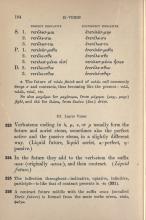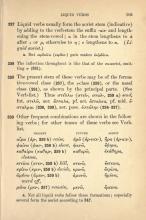323. Verb stems ending in -λ, -μ, -ν, or -ρ usually form the future and aorist stems, sometimes also the perfect active and the passive stems, in a slightly diferent way. (Liquid future, liquid aorist, α-perfect, η-passive.)
324. In the future they add the suffix -εο:ε- to the verb stem (originally -εσο:ε-), and then contract. (Liquid future)
325. The inflection throughout—indicative, optative, infinitive, participle—is like that of contract presents in -έω (§ 331).
326. A contract future middle with the suffix -σεο:ε- (so-called Doric future) is formed from the mute verbs πῑ́πτω, πλέω, φεύγω.
327. Liquid verbs usually form the aorist stem (indicative) by adding the suffix -α:ε- to the verb stem and lengthening the stem vowel; -α- in the stem lengthens to -ᾱ- after -ι- or -ρ-, otherwise to -η-; -ε- lengthens to -ει-. (Liquid aorist)
a. But κερδαίνω (κερδαν-, gain) makes ἐκέρδᾱνα.
328. The inflection throughout is like that of the σα-aorist, omitting -σ- (§ 331).
329. The present stem of these verbs may be of the formative-vowel class (§ 257), the ι-class (§ 259), or the nasal class (§ 261), as shown by the principal parts. (See Verb-list.) Thus στέλλω (στελ-, σταλ-, § 259.a) send, has future στελῶ, aorist ἔστειλα, perfect active ἔσταλκα, perfect middle ἔ-σταλμαι (§§ 338 and 339), aorist passive ἐστάλην (§§ 334 – 337).
330. Other frequent combinations are shown in the following verbs; for other tenses of these verbs see Verb-list.
|
Present |
Future |
Aorist |
|
αἴρω, raise |
ᾱ̓ρῶ |
ἦρα |
|
φαίνω, show |
φανῶ |
ἔφηνα |
|
καθαίρω, cleanse |
καθαρῶ |
ἐκάθηρα |
|
κτείνω, kill |
κτενῶ |
ἔκτεινα |
|
κρῑ́νω, decide |
κρινῶ |
ἔκρῑνα |
|
ἀμῡ́νω, ward off |
ἀμυνῶ |
ἤμῡνα |
|
μένω, remain |
μενῶ |
ἔμεινα |
a. Not all liquid verbs follow these formations; especially several form the aorist according to § 347.


